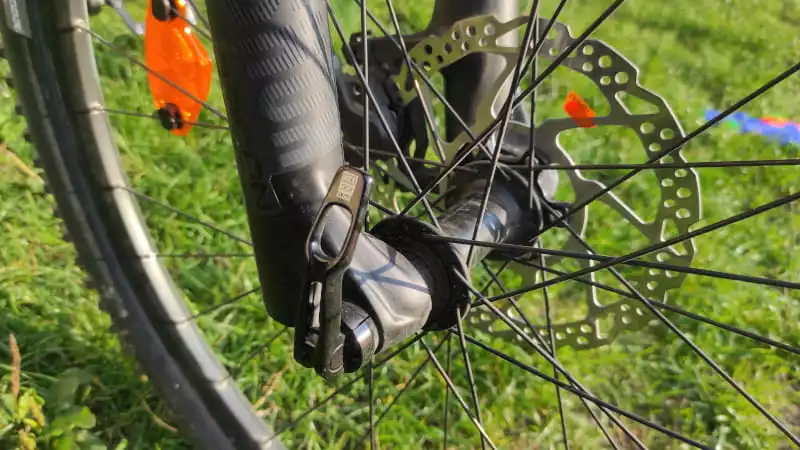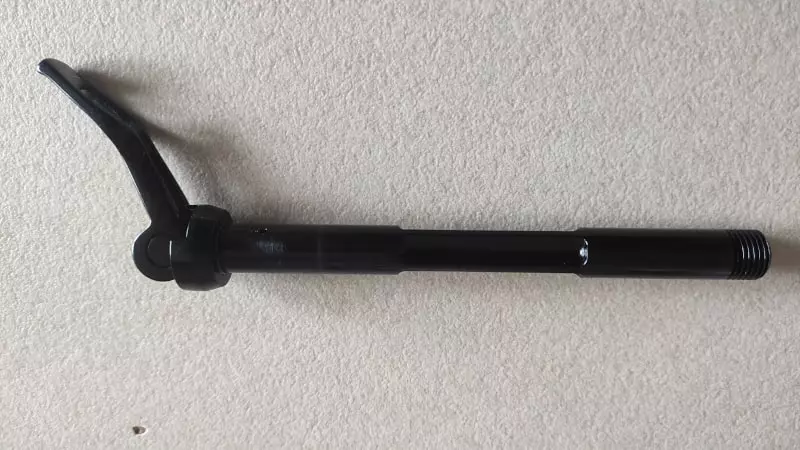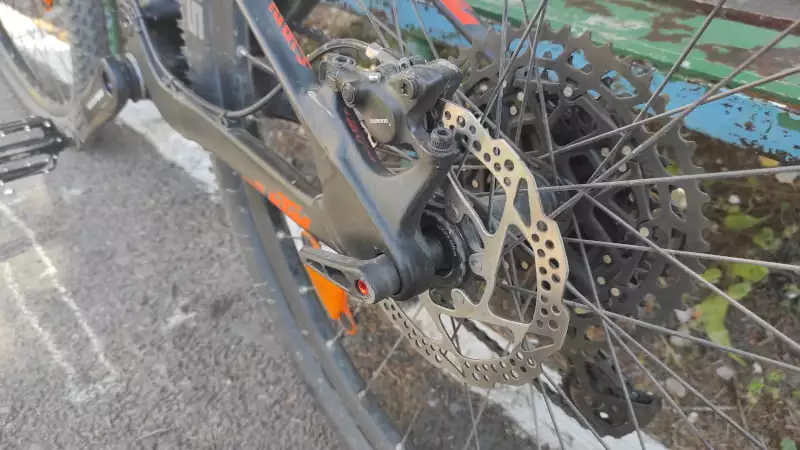The Quick Release (QR) and Thru-Axle (TA) are the most common axle systems for modern mountain bikes, while each has its pros and cons, there are some significant differences between them.
Let’s look at some of the most critical aspects of each system below, examine and compare them and then decide which system is better and why, and which one would ultimately become the preferred choice on your bike.
A Brief History Of the Quick-Release Axle

In 1927, an Italian rider named Tullio Campagnolo (sound familiar?) was racing through the Dolomites and ended up with a wingnut stuck in his axle, which cost him time and ultimately the race.
This incident inspired him to develop a quick-release system that substantially reduced the time for riders to replace wheels as needed. Patented in 1930, the QR axle became the world standard for the next 90 years.
Besides patenting other cycling-related devices, he found the Campagnolo cycling company, a highly respected and successful worldwide brand.
A Brief History of The Thru-Axle System
Campagnolo’s design held fast until the introduction of fast downhill mountain bike racing. During the bike’s stresses of speed and pressure, the QR axles began to fail more often, bending and breaking during riding.
With the proliferation of disc brakes and suspension forks in mountain bikes, the forks didn’t move in unison under compression and braking, leading to brake rotor misalignment, poor turn tracking, and even wheels detaching while in motion!
Another issue was the disc braking system on mountain bikes could sometimes EJECT the wheel from the drop-out under heavy braking.
It was clear that a new, more robust axle system was needed to handle the stresses produced with the advent of new braking and suspension systems.
Advantages Of Thru-Axles Over Quick Release

There are several distinct and considerable advantages of the TA over the QR. Safety, improved braking, and strength under stress are just a few. Let’s explore the pros and cons of each, starting with the safety aspect.
The Safety Overview
The most significant advantage that Thru-Axle has over QR is safety. Firstly, as the axles are thicker, there is almost zero chance of bending or breaking under stress, as was common with the QR system.
It also makes it impossible for the front wheel to come out of the drop-outs because they are screwed into the fork and the frame. The drop-outs cant lift off the wheel either as they don’t have the u-shape like the QR system, so the drop-out completely surrounds the axle.
With the TA in place, braking improved, and the risk of the wheel coming loose under severe braking was eliminated as with the axle now locking the forks together, there is no way the wheel could come loose.
With the QR axle, if the cam wasn’t tightened properly, this could cause the wheel to oscillate in the fork causing steering instability or ejection from the fork. The Thru-Axle attachment is far more secure is more stable even if not fully tightened.
Let’s examine these in more detail and then look at the QR System’s pros and cons.
Fork Flex Stability
Standing up to the pedal exerts forces through the forks, and this causes the forks to flex. There can be enough torque to push the brake pad to rub against the rotor when this happens. The TA reduces flex because of its inherent increased strength.
Because the brake pads are only millimeters away from the rotor, it can happen quite easily. The net result is a reduction in efficiency and speed due to friction and an annoying sound to boot!
The Thru-Axle system also adds some marginal improvement in braking as the brake rotor stays consistently aligned with the brake caliper. The more robust, more rigid connection between the hub and the fork legs improves front-end stability.
Strength Under Stress
The main reason for the TA system’s development was the increased QR axle incidents under the immense stress of downhill riding. Landing heavily after jumps or drops often leads to thinner axles bending or breaking.
On bikes with suspension forks, the fork’s travel on impact exerts a tremendous force on the QR axle. If the fork legs compress unevenly, that can bend or break the axle. A bent axle can then damage or destroy the wheel hub, and if the axle breaks, the wheel can come off.
The TA axle is 3-4 times thicker, and the added material makes it much more substantial. Also, because it is threaded and screwed into the fork, there is far more strength in the front end. With the TA axle in place, the forks compress evenly and eliminate the risk of damage.
The additional benefits include better handling and braking as well as safety.
Braking
With the QR axle on a disc brake system, the act of braking forces the wheel forward and down. This means that with the U-shaped drop-out, every time brakes are applied, the wheel wants to almost push itself out of the fork! At speed and downhill, this would not be safe at all!
After a period of extended braking, the QR axle can gradually loosen, leading to the wheel being ejected from the fork. On rim brake bikes, the forces push the wheel back into the drop-outs. With the through-holes of the TA, the axle cannot pull out vertically, which solves the braking ejection problem completely.
Performance

By stiffening the front end of the bike, handling, cornering, and stability are vastly improved, which is one of the most significant benefits of the TA system.
You can steer with greater precision and accuracy and front-wheel tracking, while cornering is much better as the attachment to the bike is more rigid. Even compression of the fork delivers better handling and steering while braking.
Off-road handling is sharper and allows for better rough technical terrain navigation and the ability to carry heavier loads when touring.
QR VS TA – Fork Failure & Fatigue
The disc brake system only brakes one side of the rotor, which causes torsion forces to be exerted on the forks, causing them to want to twist. Because the forks don’t absorb that force evenly with the QR system, this causes fork fatigue and, over time, fork failure.
Thru-Axles bolt the fork together, resulting in an even distribution of torsion forces. The much more rigid and stable front end increases torsion resistance, thus reducing flex and failure. Replacing forks on any bike can be a costly exercise.
Consistent Wheel and Brake Alignment
If you’ve ever taken a QR wheel off and then put it back in after changing a tire, you no doubt have experienced this. Even when taking the utmost care in undoing the nut and the cam, there inevitably needs to be some readjustments required when refitting.
This is due to the fundamental inconsistency in the design. The nut, springs, and cam are not usually consistently and meticulously loosened and tightened, so you can never get the axle back on the same as when you took it off.
Slight misalignment on re-insertion can lead to the cassette sitting crooked if this is a rear-wheel replacement and lead to poor drive train movement. Also, the brake rotors and rim are offset, causing the brakes to rub on the disc.
With the Thru-Axle, this is eliminated. The consistent rigid structure of the design delivers accurate removal and replacement of the axle every time. While it takes a bit longer, this is offset by the consistency of installation and the resulting performance.
Cost
Here is one area where QR has an advantage -price. A single TA can cost between $30 and $60, while a pair of QR’s come for just $10-$20 a set.
Thru-Axle frames and forks also cost more to make due to their greater complexity and manufacturing time. There is no margin for error in manufacture with the precision required for the TA frames and forks.
The QR forks and frames have a more significant margin for errors as the technical side of the manufacturing process does not have to be as concise as with the thru-axle process. They have more adjustability during the manufacturing process.
Weight
The Thru-axle system is heavier than the quick-release, and this is simply due to the thickness and density of the axle, a standard thru-axle weighs 60-80grams compared to a quick-release axle which usually weighs only 40-50grams.
Parts and Availability
One of the drawbacks of the thru-axles is that they may not be available everywhere. If you are in a developing country and either need a new hub or lose a thru-axle, you may find that smaller bike shops may not have them available, and you may have to travel to a bigger city or have it shipped in.
This is why many bicycle tourists stick with quick-release axles, as they are widespread and easy to find.
As a development, though, some manufacturers of touring bikes are starting to produce thru-axles since this is the least likely part to break on a tour ride.
Maintenance and Bike Stand & Bike Rack Compatibility
It’s easier and quicker to release and remove the quick-release axle than the thru-axle, which saves a lot of time during races or maintenance.
Many racing teams have a new bike standing by instead of taking time and losing seconds to the longer time needed to switch out a thru-axle wheel. For the average rider, taking a few extra seconds or minutes is not of extreme importance.
Remember that the thru-axle system is for high-end riders doing downhill or similar events where the bike is subject to impact and braking forces outside everyday use.
Most bike repair stands are designed to work with the most common axle system, the quick-release, and you may find that the thru-axle may be challenging to work with on some bike repair stands.
As far as bike racks are concerned, the existing ones built for the quick-release axle become obsolete if you get a thru-axle bike. You may need to buy a rack compatible with the thru-axle, and those are becoming more common as the thru-axle does. The good news is that there are now thru-axle adaptors that you can fit into your existing bike rack!
Thru-Axle on Road Bikes
One of the big motivators for developing the thru-axle was the increasing use of disc brakes on mountain bikes and how this causes quick-release axles to eject under braking force or impact.
Over the past few years, the disc braking system has started to become more commonplace on road bikes, and there may be a case for converting to the thru-axle as well. With the existing rim brake system, a thru-axle is not required.
However, if the road bike has a disc system, the same force dynamics under braking will have the same effect on quick-release axles on the road.
Consider also that the degree of braking and impact forces would not be as high on the road as on an MTB, but safety is always a priority, and having your wheel eject under severe braking on the road would not be good.
Conclusion
While some consider introducing the thru-axle and associated bikes and products to be another way for the industry to sell more parts and bikes for downhill and MTB riders, this system has vastly improved safety and reduced the risk of injury since its introduction.
While this may be partially true, the evolution to a safer, more robust axle that improves handling, safety, and braking and significantly reduces the risk of injury can only be a good thing.
As this technology develops, it will become cheaper and more freely available and gain popularity with more and more riders because everyone, regardless of what and where you ride, wants to be safe.
Related articles:
I started mountain biking many years ago to improve my overall health state. After my first ride, I fell in love with the sport. Now I spend dozens of hours a week researching and training to compete in local XC and Enduro events.

